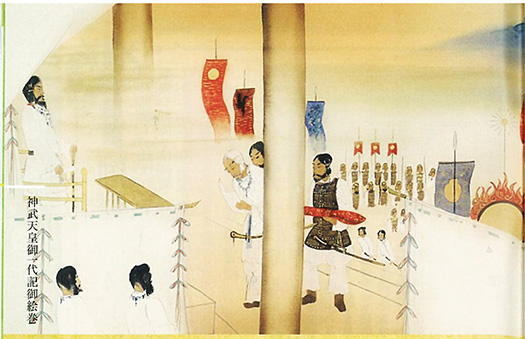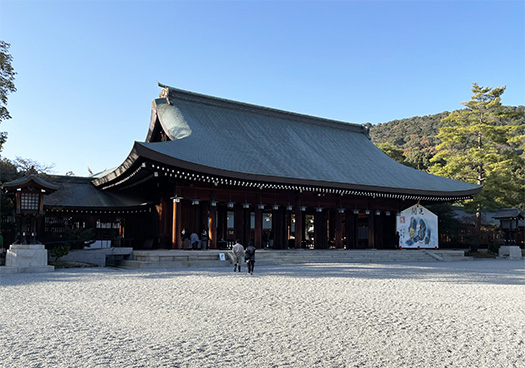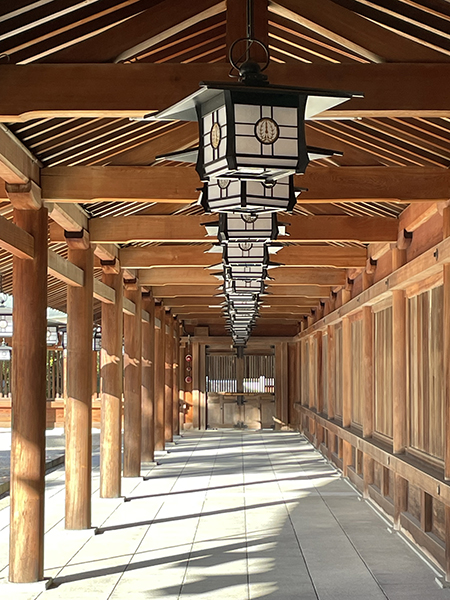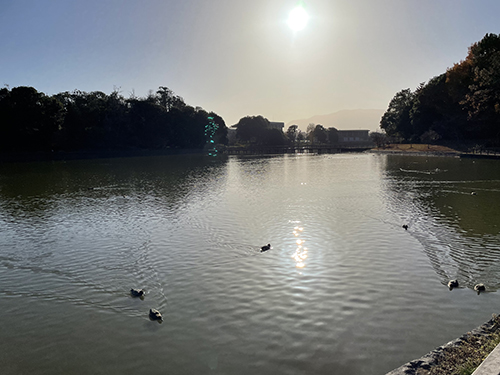


いま奈良県橿原市に広大な敷地をもって建てられている「橿原神宮」は、創建としては明治になってからで1890年4月2日。神武天皇が橿原宮で即位したという「日本書紀」の記述に基づき、畝傍山の東南麓に明治23年(1890) に創建された。祭神は神武天皇と媛蹈韛五十鈴媛皇后(ひめたたらいすずひめこうごう)。この皇后は出雲の大国主の息子の事代主神の娘とされ、その名に「たたら」という製鉄のことだまを響かせている。
天皇という存在は稲作農耕社会秩序を象徴するような役割があると思うけれど、初代天皇にも「農耕鉄器」との所縁が投影されているようにも感じられる。
神武天皇の御陵が、橿原神宮に隣接する現在地に定められたのは幕末の1863年。明治10年代になると橿原宮址を調査し顕彰しようという動きが高まり、民間から宮址碑の建立や橿原神社の創建の出願が相次いだとされる。
こういう流れから考えれば、明治の時代精神として皇統の称揚気運が高まって社地が整備されていったという経緯が表現されている。しかし逆に言うと、国譲りした出雲大社が歴世、荘厳な社殿を維持し続けていたことと比べれば、皇統紀元の「宮建築」は驚くほどのあっけなさで顧みられなかったことになる。日本の建築の歴史でも出雲大社は特異的な規模と承継性を持っている一方、大和政権のさりげなさが特徴的ではないか。
その後の皇統の宮はあらたに天皇が即位するとあらたな宮が作られて、点々と移転し続けるというスタイルを取っていくことになる。東アジア的な「都城」の建設は6-7世紀の飛鳥京まで待たねばならない。そもそも都城を建設するという思想自体、対中国王朝との外交関係が主たる動機となっている。皇統始原の段階ではそのような志向性はなかった、もしくは希薄だったといえるのだろう。そうしたことからそもそも神武天皇が実在したのかどうか、という論議を呼んでいる。「皇統神話」とした由縁だけれど、しかし一方で熊野に触れて、そのこととの関わりで考えれば、いかにも神話と歴史のあわい接点という印象も強く感じられる。

北海道人として熊野という地域についてはほとんど知識もないままに、しかしなにかに惹かれて歩いてみて、そのロマンに深く「鷲づかみ」されてしまった(笑)。言語による表現以前の、話し言葉での伝承段階から、たぶん縄文から弥生への時代変容の痕跡が、熊野には濃厚に残っているのだと思う。
その後の皇統はこのような地域文化を有効活用しながら、自らの祖先神話の世界を盛り上げていった側面があるのだろう。そういう意味で意図的かそうでないかは別にして、日本文化のいろいろな始原にかかわることがらが文化風土として残り続けている。今後も、折に触れて探訪してみたい。
English version⬇
The “Accession” to the Throne” Kashihara, Nara, Japan: The Myth of the Imperial Lineage and the Journey to Kumano – 33]
The Jimmu Expedition to Kumano. This is an exploration of an area that is not clear as to whether it is myth or history. After all, is it a way to “transmit” the social transformation from the Jomon to the Yayoi period through expressions that transcend language? by …
The Kashihara Shrine, now built on a vast site in Kashihara City, Nara Prefecture, was founded on April 2, 1890, in the Meiji era (1890-1912). The shrine was built in 1890 at the southeast foot of Mt. Unebi, based on the account in the “Chronicles of Japan” that Emperor Jinmu ascended to the throne at Kashihara Palace. The deities are Emperor Jinmu and Empress Ehime Tadasu Isuzu Kogo. This empress is said to be the daughter of Kotoshironushi, the son of Okuninushi of Izumo, and her name echoes the iron-making word “tatara.
The existence of an emperor is symbolic of the social order of rice cultivation and agriculture, and it seems that the first emperor also has a projected connection with “agricultural ironware.
It was in 1863, at the end of the Edo period, that Emperor Jinmu’s mausoleum was located at the present site adjacent to the Kashihara Shrine. In the 10th year of the Meiji Period, there was a growing movement to investigate and honor the site of the Kashihara Palace, which led to a series of applications from the private sector for the erection of a monument at the palace site and the establishment of the Kashihara Shrine.
This trend suggests that the Meiji period’s spirit of honoring the imperial lineage led to the development of the shrine site. Conversely, however, compared to the fact that Izumo-taisha, which had been handed over to the state, continued to maintain its majestic shrine pavilions for generations, the “palace architecture” of the imperial era was surprisingly neglected. In the history of Japanese architecture, Izumo-taisha is unique in its scale and succession, while the casualness of the Yamato regime is characteristic.
The subsequent palaces of the imperial lineage were built when a new emperor ascended to the throne, and were continually relocated from place to place. The construction of a capital city in the East Asian style had to wait until the Asuka-kyo capital in the 6th-7th century. The idea of building a capital city was primarily motivated by diplomatic relations with the Chinese dynasties. At the beginning of the imperial lineage, there was no such orientation, or it could be said that such an orientation was weak. This has led to a debate over whether Emperor Jinmu really existed in the first place. This is the reason why the book is called “the myth of the imperial lineage,” but on the other hand, if you think about it in relation to Kumano, you can get the strong impression that it is a crossroads between myth and history.
As a Hokkaido native, I knew little about the Kumano region, but something about it drew me to walk there, and I was deeply “gripped” by its romance (laughs). I believe that Kumano retains traces of the transformation from the Jomon to the Yayoi period, probably from the stage of spoken tradition before language expression.
The subsequent imperial lineage may have made effective use of this local culture to enhance the world of its own ancestral mythology. In this sense, whether intentionally or unintentionally, things related to the origins of Japanese culture continue to remain as part of the cultural climate. I would like to continue to visit these places from time to time in the future.
Posted on 2月 8th, 2024 by 三木 奎吾
Filed under: 住宅取材&ウラ話







コメントを投稿
「※誹謗中傷や、悪意のある書き込み、営利目的などのコメントを防ぐために、投稿された全てのコメントは一時的に保留されますのでご了承ください。」
You must be logged in to post a comment.